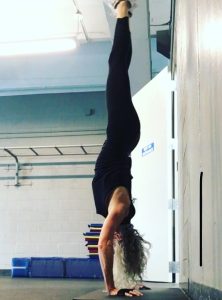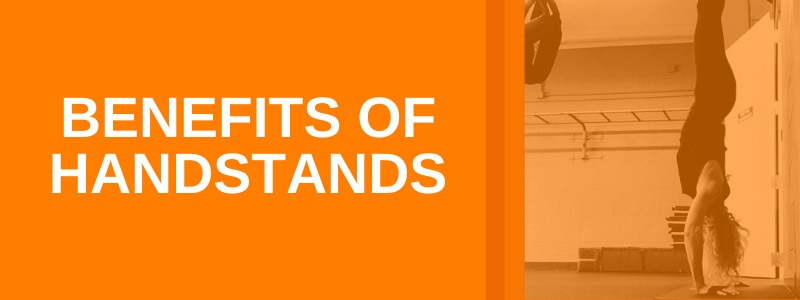Inversions have many benefits when incorporated into a workout. Some are easily performed while others take lots of practice. There are many fitness enthusiasts challenging themselves to learn handstands, which are an inversion. The benefits of doing inversions vary based on the type of inversion.
Inversions position the body to be upside down, which shakes things up a bit. The inverted position might be all the way, like a backbend. Or it might be halfway, like a bridge pose. Or it might be a relaxing pose like legs up the wall.
If you have attended a yoga class, chances are you have seen various inversion poses as part of the practice. However, inversions are not just for yogis!
While there are many exercise inversions, one stands out above the others. I did research and talked with two fitness pros about the benefits of  inversions and they both raved about handstands. I admit, I have my own love of handstands.
inversions and they both raved about handstands. I admit, I have my own love of handstands.
Merriam-Webster Dictionary defines a handstand as “an act of supporting the body on the hands with the trunk and legs balanced in the air.” What sounds simple in words is actually complex in movement.
Kellen Nyemb, E-RYT 500, is a fan of handstands. “Inversions benefit all of the body’s systems, and each inversion has its own set of benefits, but handstand is my favorite for a few reasons,” she said. “Handstands are a complex movement, one that most of us are not used to and which we definitely were not designed to do. Because of this, they are so good for the brain. New movement patterns increase our neuroplasticity, meaning handstands can grow our brains!”
Handstands take practice and determination. “The time that it takes to work up to handstand requires patience, discipline, humility, and perseverance,” Nyemb said. “To grow and get stronger in these areas is a benefit in and of itself. Finally, handstands may not be functional – though the core strength they build is – but they are fun! And we could all benefit from a little more joy.”
Executing a handstand utilizes muscle memory, which provides mental and physical cooperation. Like so much in the exercise world, there is a mind and body correlation. It engages the core, uses upper body strength, balance, and a whole slew of muscles. Plus, you get to look at the world from a whole different angle.
Talk about joy! Once you get up and hold a handstand, it is hard to wipe a smile from your face. Handstands are a challenge by their own right. Many people are intimidated by them and believe they are not capable of even attempting the position, which requires strength and mobility to maintain.
I personally saw them as a challenge following shoulder surgery; I made the handstand a goal during my recovery.
Some researchers found that performing daily handstands has its benefits. I spoke with ACE-certified personal trainer Cindy Brown about them. She incorporates handstands into her own workouts five to six days a week holding the handstand for a minute. “Handstands have amazing benefits,” she said. “Your shoulders and arms bear 100% of your body weight in a handstand. Thus, handstands strengthen wrists, shoulders, core, upper back, and hamstrings. They improve balance, boost mood, improve bone health, circulation, and breathing. They also stimulate the thyroid and help regulate metabolism.”
Teaching Clients to do Handstands
When helping clients learn to do handstands, Brown has some suggestions. “Trainers spot clients learning to do handstands,” she said. Use a wall for added assurance. Beginners can start by facing a wall and “climbing up” with their feet until they can push off of the wall. Be there to catch their ankles and help to steady them.
As they improve, they can turn their bodies away from the wall, and attempt to initiate the handstand as in the video below:
Handstand video credit to Kellen Nyemb @kellen.yoga on Instagram.
The heels will likely hit the wall at first until they learn to balance properly at the start of the handstand.
“Once they nail one, try having them hold it for as long as possible. Hands and wrists will probably get sore, but their body will adapt and become strong. Progress to handstand pushups for advanced clients.”
Handstands are not for everyone though. Trainers should determine if handstands are appropriate for a client’s training. Limited mobility, especially in the shoulders and wrists, should be improved before even attempting a handstand. Many people who have desk jobs have overactive digital flexors from typing, making their ability to full extend their fingers while also extending their wrists (handstand position) far too uncomfortable if not impossible. Similarly, short lats and the medial rotators of the shoulder joint will prevent the arm from extending to 180 degrees, which is necessary for a successful handstand.
If you have a client determined to learn how to do a handstand but suffers from such limitations, explain to them that they have to crawl before they walk, and that tackling the mobility issues will not only help them achieve a successful handstand, but will also make their other movements more efficient and keep a healthy posture.
References:
https://www.mindbodygreen.com/0-11284/5-reasons-you-should-do-handstands-every-day.html
https://www.crossroadsoffitness.com/uncategorized/10-simple-steps-master-freestanding-handstand/#:~:text=The%20handstand%20is%20similar%20however,a%20ticket%20to%20the%20show.
Photo credit to Cindy Brown @southiebelle
Kim Becknell Williams is a freelance writer with more than ten years of personal training experience. Certified through NFPT, she is a Functional Training Specialist and holds a Master Trainer level certificate for resistance, endurance and sports nutrition. Kim has written two books including Gym Etiquette 101. She enjoys writing a variety of lifestyle articles and fitness blogs.


